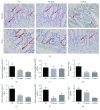The Effects of Sleeve Gastrectomy on Glucose Metabolism and Glucagon-Like Peptide 1 in Goto-Kakizaki Rats
- PMID: 29670912
- PMCID: PMC5835276
- DOI: 10.1155/2018/1082561
The Effects of Sleeve Gastrectomy on Glucose Metabolism and Glucagon-Like Peptide 1 in Goto-Kakizaki Rats
Abstract
Purpose: To investigate the effects of sleeve gastrectomy (SG) on glucose metabolism and changes in glucagon-like peptide 1 (GLP-1) in Goto-Kakizaki (GK) rats.
Methods: GK rats were randomly assigned to one of three groups: SG, SG pair-fed plus sham surgery (PF-sham), and ad libitum-fed no surgery (control). Food intake, body weight, blood glucose, GLP-1 and insulin levels, and GLP-1 expression in the jejunum and ileum were compared.
Results: The SG rats exhibited lower postoperative food intake, body weight, and fasting glucose than did the control rats (P < 0.05). SG significantly improved glucose and insulin tolerance (P < 0.05). Plasma GLP-1 levels were higher in SG rats than in control or PF-sham rats in the oral glucose tolerance test (OGTT) (P < 0.05). Blood glucose levels expressed as a percentage of baseline were higher in SG rats than in control rats after exendin (9-39) administration (P < 0.05). The levels of GLP-1 expression in the jejunum and ileum were higher in SG rats than in PF-sham and control rats (P < 0.05).
Conclusions: Improvement of glucose metabolism by SG was associated with increased GLP-1 secretion. SG contributes to an increase in plasma GLP-1 levels via increased GLP-1 expression in the mucosa of the jejunum and/or ileum.
Figures






Similar articles
-
Effect of sleeve gastrectomy on body weight, food intake, glucose tolerance, and metabolic hormone level in two different rat models: Goto-Kakizaki and diet-induced obese rat.J Surg Res. 2013 Nov;185(1):159-65. doi: 10.1016/j.jss.2013.05.019. Epub 2013 May 28. J Surg Res. 2013. PMID: 23746960
-
Therapeutic Effects of Sleeve Gastrectomy and Ileal Transposition on Type 2 Diabetes in a Non-Obese Rat Model by Regulating Blood Glucose and Reducing Ghrelin Levels.Med Sci Monit. 2019 May 9;25:3417-3424. doi: 10.12659/MSM.913705. Med Sci Monit. 2019. PMID: 31068569 Free PMC article.
-
Type 2 diabetes control in a nonobese rat model using sleeve gastrectomy with duodenal-jejunal bypass (SGDJB).Obes Surg. 2012 Dec;22(12):1865-73. doi: 10.1007/s11695-012-0744-7. Obes Surg. 2012. PMID: 22911149
-
Effect of Sleeve Gastrectomy Plus Side-to-Side Jejunoileal Anastomosis for Type 2 Diabetes Control in an Obese Rat Model.Obes Surg. 2016 Apr;26(4):797-804. doi: 10.1007/s11695-015-1811-7. Obes Surg. 2016. PMID: 26202420
-
Glucose Homeostasis Improvement After Single Anastomosis Duodenojejunal Bypass with Sleeve Gastrectomy in Goto-Kakizaki Rats.Obes Surg. 2025 May;35(5):1620-1629. doi: 10.1007/s11695-025-07799-4. Epub 2025 Mar 25. Obes Surg. 2025. PMID: 40128514 Free PMC article.
Cited by
-
Study on the Hyperglycemic Effect of GLP-1 in Spinibarbus denticulatus by Oral Administration and Intraperitoneal Injection Methods.Aquac Nutr. 2023 Apr 3;2023:9969406. doi: 10.1155/2023/9969406. eCollection 2023. Aquac Nutr. 2023. PMID: 37051050 Free PMC article.
-
State of art on the mechanisms of laparoscopic sleeve gastrectomy in treating type 2 diabetes mellitus.World J Diabetes. 2023 Jun 15;14(6):632-655. doi: 10.4239/wjd.v14.i6.632. World J Diabetes. 2023. PMID: 37383590 Free PMC article. Review.
-
Meal patterns after bariatric surgery in mice and rats.Appetite. 2020 Mar 1;146:104340. doi: 10.1016/j.appet.2019.104340. Epub 2019 Jun 29. Appetite. 2020. PMID: 31265857 Free PMC article. Review.
-
Gastric Sleeve Surgery Alleviates Obesity-Associated Insulin Resistance and Suppresses Endoplasmic Reticulum Stress in Adipose Tissue of db/db Mice.Obes Surg. 2019 Oct;29(10):3220-3227. doi: 10.1007/s11695-019-03966-6. Obes Surg. 2019. PMID: 31197603
References
MeSH terms
Substances
LinkOut - more resources
Full Text Sources
Other Literature Sources
Medical

